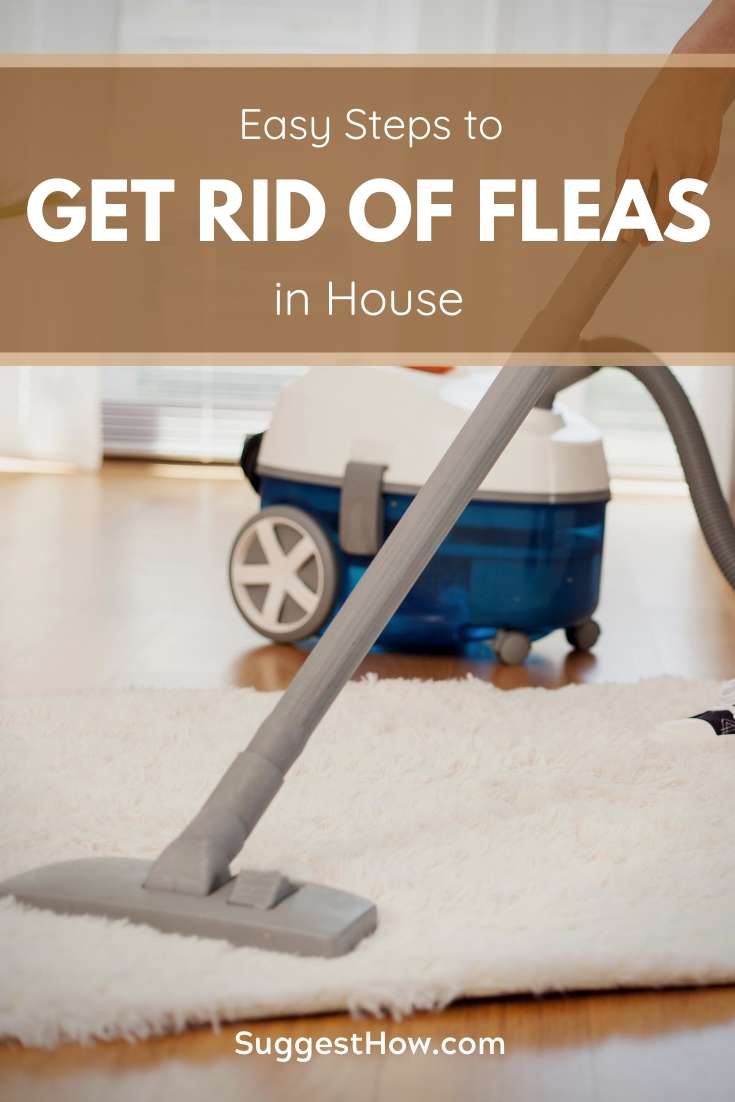Table Of Content

Ask your vet if a treatment called nitenpyram (the brand name is Capstar) is right for your dog or cat because it can usually get rid of fleas within 24 hours. Fleas can be dangerous for your cat, along with the other animals and people in your home. The ideal way to treat fleas is a combination of the tasks mentioned above, along with prescription flea medication from your veterinarian.

Wash all bedding in hot, soapy water
Pay close attention to floors, upholstery, mattresses, and those hard-to-reach corners. Once you have finished vacuuming, empty the bag or filter immediately. Fleas are tiny insects (1/16 to 1/8 of an inch long) that commonly live as parasites on cats, dogs, and other warm-blooded animals. They are wingless and usually reddish-brown, with hard, polished bodies covered with microscopic backward-pointing spines and hairs. The CDC recommends environmental treatments for flea extermination, including having a professional apply an insecticide in your home or yard. For heavy infestations, it’s best to toss everything into a kitchen trash bag, seal it, and throw it out, according to Terminix pest control services.
Control Fleas on Your Pet, in Your House, and in Your Yard Mississippi State University Extension Service - Mississippi State University
Control Fleas on Your Pet, in Your House, and in Your Yard Mississippi State University Extension Service.
Posted: Fri, 22 Apr 2016 01:38:48 GMT [source]
How to get rid of fleas in the bed
First, you can give your pets preventive flea medication, which includes repellent collars and topical applications that prevent fleas from biting. Permethrin is a common chemical in these treatments that repel and kill fleas, according to the Cornell University College of Veterinary Medicine. Applications containing permethrin can also repel ticks, mosquitoes and other insects. The EPA warns homeowners about the use of non-EPA-approved pesticides and the dangers of using some over-the-counter flea treatments.
What About Cat Shampoo?
We always recommended boarding pets or having them stay with a friend or family member during the treatment process. In order to live flea-free, you need to clean your home while simultaneously ridding fleas from your pet. If you live in a house with a yard, your pets, house, and yard all need to be treated within a 24-hour period of each other. Both can be readily controlled,' explains veterinary surgeon, Neil McIntosh.
Top local pest control pros in major cities
Prune your bushes and tree branches to allow more sun to penetrate through to the ground. Fleas try to avoid the sun as they prefer dark environments. Too short, and insects that eat fleas (like ants and spiders) won't want to show up there either. Ideally, once your washing cycle is done, you should hang everything outside in the sun. Alternatively, drying your washing on the HOT heat cycle is the next best option.
Fleas are more likely to hang out in carpeting in these areas than in areas rarely visited by pets or people. Remove fleas harbouring in the fibres of your carpet by using baking soda. To do this, sprinkle some on your carpet, scrub it and then vacuum it up. Likewise, regularly vacuuming your carpet will also help to keep the pests at bay.

Treating your pet will go a long way toward solving your flea problem, but you must treat your home to prevent your pet from attracting more pests. Below are some methods on how to get rid of fleas in your house. The larvae will then create a cocoon that protects them as pupae until they have developed into adult fleas. “The pupal stage is more concealed, and their cocoon is typically too resilient for pesticides to penetrate,” said Hess. This is a major contributing factor to the challenge of getting rid of fleas. Flea traps produce light and warmth, which naturally attract fleas, according to the Illinois Department of Public Health.
The interior design of this open-plan house is tasteful, with neutral and pastel colours dominating the palette. You can make the most of the separate stables, which house a rather unique bar with a fireplace. Simply bring your own beer, stoke up the wood-burner and test your skills at traditional darts.
natural pest management
If you miss any bugs, you could be trapped in a life cycle of misery trying to remove them from your home as they repopulate. If you have a serious flea invasion, have your carpets steam cleaned. The heat will kill the fleas, but it may not kill all the eggs. They may hatch later, and you may have to steam clean again. If regular vacuuming isn’t enough, try sprinkling some salt or baking soda on the carpet or furniture first.
Your pet is a member of the family, but sometimes it can unknowingly invite an unwelcome guest that puts you on flea removal patrol. Fleas jump on and off animals from the ground, so if your dog or cat goes outdoors, chances are it will bring them indoors. Fleas are one of the most annoying insect infestations that can occur in a home, especially because they bury themselves in carpets, couches, and seemingly every corner of a room.
You may need to bathe Fido—and dare we say, Kitty too—more regularly if fleas are prevalent in your home. Ask your vet to recommend a flea shampoo that will kill the critters. After each bath, apply a flea treatment, whether a topical medication, a flea collar, or both. You might use a spray that contains chemicals such as methoprene, which ends an infestation by disrupting the flea’s life cycle, or one that contains an insecticide such as etofenprox. If you prefer, you can opt for a spray that relies on natural ingredients, such as cedarwood oil, to kill fleas. If fleas have migrated to upholstery, they can easily make their way back into the carpet.
Salt and baking soda both can hurt fleas by drying them out. Leave it on for 24 hours or up to a week before you vacuum it up. Fleas are after blood and can bite people or latch onto our clothes or shoes. Pets are ideal hosts because thick fur provides plenty of shelter for fleas to latch onto skin and feed, or lay eggs. A flea infestation can test your patience and require persistence. But you can eradicate the problem with a combination of cleaning methods, sprays, and pet-friendly topical medications among other options.














